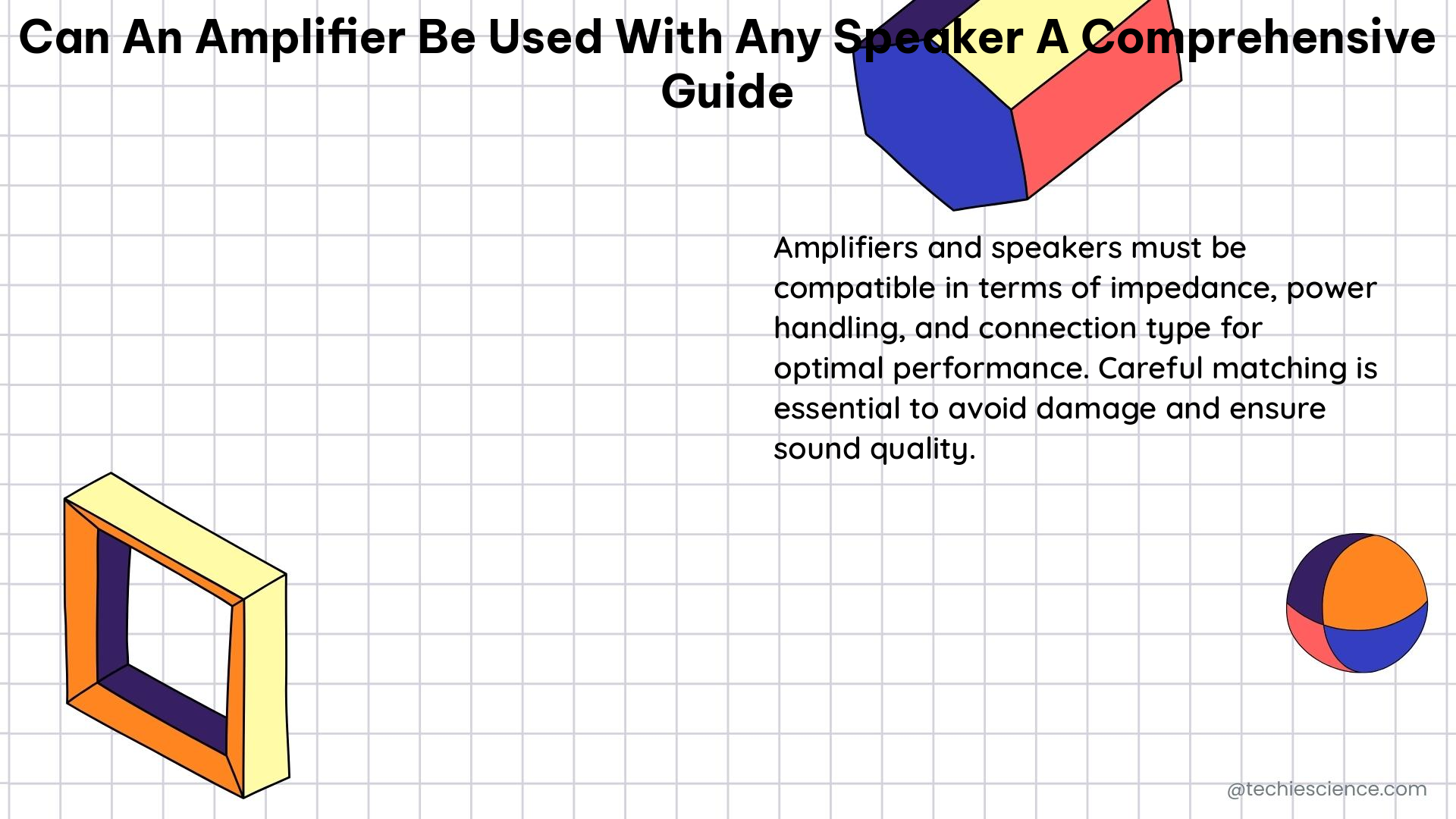Can an amplifier be used with any speaker? The answer is no, and the process of matching an amplifier with a speaker is a crucial one that requires careful consideration of several technical specifications. This comprehensive guide will delve into the intricacies of impedance matching, power handling, wattage, sensitivity, and other critical factors to ensure safe and efficient operation of your audio system.
Impedance Matching
Impedance is a measure of the electrical resistance of a component, measured in ohms (Ω). Speakers and amplifiers have specific impedance ratings that must be compatible to ensure efficient and safe operation.
For example, if an amplifier is rated for 8Ω speakers, it is recommended to use 8Ω or higher (like 16Ω) speakers. Connecting speakers with a lower impedance rating than the amplifier’s lowest range can result in permanent damage to either the speakers or the amplifier.
Some amplifiers are more flexible and can handle a wide range of impedances, with some power amps even offering 2Ω stable operation and protection circuits that shut down when they recognize a mismatch. However, it’s essential to consult the manufacturer’s specifications to ensure compatibility.
| Amplifier Impedance | Recommended Speaker Impedance |
|---|---|
| 4Ω | 4Ω or higher |
| 8Ω | 8Ω or higher |
| 16Ω | 16Ω or higher |
Power Handling

Power handling is the amount of power a speaker can handle without being damaged, measured in watts (W). When matching an amplifier with a speaker, it is crucial to ensure that the amplifier’s power output is within the speaker’s power handling range.
Using an amplifier with a power output significantly higher than the speaker’s power handling range can damage the speaker. For example, if a speaker has a power handling range of 50-100W, it would not be recommended to use an amplifier with a power output of 200W.
| Speaker Power Handling | Recommended Amplifier Power Output |
|---|---|
| 50-100W | 50-100W |
| 100-200W | 100-200W |
| 200-400W | 200-400W |
Wattage and Power Handling
When matching an amplifier with a speaker, it is important to consider both the amplifier’s power output and the speaker’s power handling. The amplifier’s power output should be within the speaker’s power handling range, and ideally, the speaker’s impedance should match or slightly exceed the amplifier’s recommended output impedance range.
For example, if an amplifier is rated for 8Ω speakers and has a power output of 100 watts, it is recommended to use a speaker with a power handling range of at least 100 watts and an impedance of 8Ω or higher.
Sensitivity and Efficiency
Sensitivity is a measure of a speaker’s efficiency, which is the amount of sound it produces per watt of power. A speaker with a higher sensitivity rating will produce more sound per watt of power than a speaker with a lower sensitivity rating.
When matching an amplifier with a speaker, it is important to consider both the amplifier’s power output and the speaker’s sensitivity. A speaker with a higher sensitivity rating will require less power from the amplifier to produce the same amount of sound as a speaker with a lower sensitivity rating.
| Speaker Sensitivity | Amplifier Power Output Requirement |
|---|---|
| 90 dB | Lower power output required |
| 92 dB | Moderate power output required |
| 94 dB | Higher power output required |
Other Factors to Consider
When matching an amplifier with a speaker, there are several other factors to consider:
- Room Size and Acoustic Properties: The size and acoustic properties of the room can impact the power requirements and speaker selection.
- Stereo versus Mono Amplifiers: Stereo amplifiers require two speakers, while mono amplifiers can drive a single speaker.
- Connectivity and Compatibility: Ensure that the amplifier and speaker have compatible connection types (e.g., RCA, XLR, banana plugs).
- Amplifier Classes and Their Impact: Different amplifier classes (A, AB, D) have varying efficiency and power output characteristics.
- Aesthetics and Practical Considerations: Consider the size, weight, and available space for the components.
By carefully considering these factors, you can ensure safe and efficient operation of your audio system.
Conclusion
Matching an amplifier with a speaker is a critical process that requires a deep understanding of technical specifications, including impedance, power handling, wattage, and sensitivity. By following the guidelines outlined in this comprehensive guide, electronics students can ensure the safe and efficient operation of their audio systems.
References
- Power Amp Buying Guide – Sweetwater
- How to Choose Amplifier for Speakers – An Easy Guide
- The Ultimate Speaker and Amplifier Matching Guide – Emotiva
- Matching amps with speakers is confusing : r/livesound – Reddit
- A Guide To Matching Speakers And Amplifiers | ElectroMarket

The lambdageeks.com Core SME Team is a group of experienced subject matter experts from diverse scientific and technical fields including Physics, Chemistry, Technology,Electronics & Electrical Engineering, Automotive, Mechanical Engineering. Our team collaborates to create high-quality, well-researched articles on a wide range of science and technology topics for the lambdageeks.com website.
All Our Senior SME are having more than 7 Years of experience in the respective fields . They are either Working Industry Professionals or assocaited With different Universities. Refer Our Authors Page to get to know About our Core SMEs.